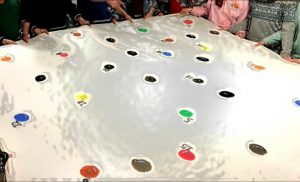LABYRINTH GAME
Classbuilding activity
This activity is suitable for each target. It is in fact possible to adapt the level of difficulty according to the age of our students. Who among you hasn’t played the labyrinth when you was child? It is a non-electronic game, usually made of wood or plastic. It is a labyrinth closed by a glass above and the goal is to make a ball travel a certain path without letting it fall into the holes along the path.
This game works in much the same way.
We can build it using a sheet or a cloth. We have to paint over the numbered stages and to create holes near the numbers. The cloth will then be held by the whole group, or part of it, and together they will have to achieve the goal. The mapping of the sheet, as well as the path that the ball will have to take to reach the goal, can vary according to the level and age of our students.
For kindergarten children, it is possible to insert two or three large holes, use a sponge ball and set the mission to be able to keep the cloth raised with the ball on it, without letting it fall for a certain number of seconds. The bigger they are, the more we can increase the difficulty by making these changes:
– Reducing the size of the ball and therefore of the holes;
– By increasing the number of holes in which the ball can fall;
– Increasing the difficulty of the path that the ball must follow to complete the group mission.

In the image drawing you can see for example that there are colored and numbered dots. In this case the ball must touch all the numbers in subsequent order.
This is a very simple game to make and very funny for any age group. You can also use it several times during the same year by changing the goal to be achieved. It allows all members, regardless of motor or mental skills, to participate in an active and totally inclusive way.
We especially recommend for the first times to propose it without the possibility of communicating in verbal form. This helps children focus on their role and not on criticizing or judging that of their partner. It is also an excellent tool for you to observe the class as a whole and, at the same time, in its individualities.
Have fun!
Ps: L’Orma recommends sharing this activity with colleagues! For example, you can propose it to the faculty before a class council or a boarding school or a planning meeting.


